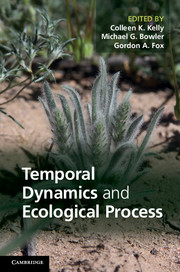1 - Introduction
Published online by Cambridge University Press: 18 December 2013
Summary
Temporal fluctuations in populations can have significant consequences for the stable coexistence of competing species, as well as for the evolution of life-history traits in a number of ways. In this volume, we examine two specific products of temporal processes: reproductive scheduling and the stable coexistence of similar species. The studies contained here principally use plants to extract general principles, with the added benefit that the observed temporal processes may also be applied to a better understanding of the resource base on which depends the larger community. The range of topics dealt with here present, as a whole, a foundation of the workings of temporal processes in nature.
Temporal cycling of plant dynamics and their role in ecosystem processes and services have potential impacts up and down the foodweb (Chesson and Kuang 2008). Taken together, these studies indicate deep ties between temporal niche dynamics (sometimes just temporal dynamics, or TND for short) and a number of fundamental ecological issues. In order to make the jump to those fundamental issues we need a better handle on what drives temporal processes in nature, and the studies included here point the way to doing so. The first section of this book addresses population persistence and species coexistence regulated by environmentally generated fluctuations. The second section of this book examines plant reproduction driven by internal processes leading to synchronised, oscillating behaviour at the population and community levels – masting in forest trees.
- Type
- Chapter
- Information
- Temporal Dynamics and Ecological Process , pp. 1 - 8Publisher: Cambridge University PressPrint publication year: 2014



